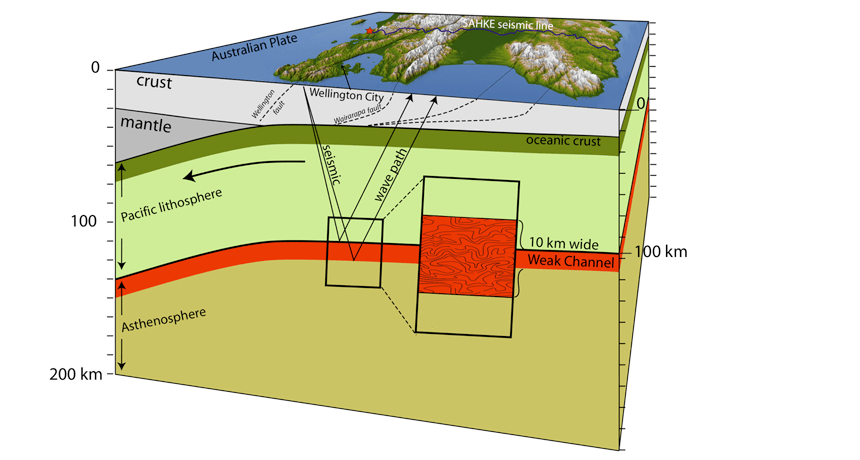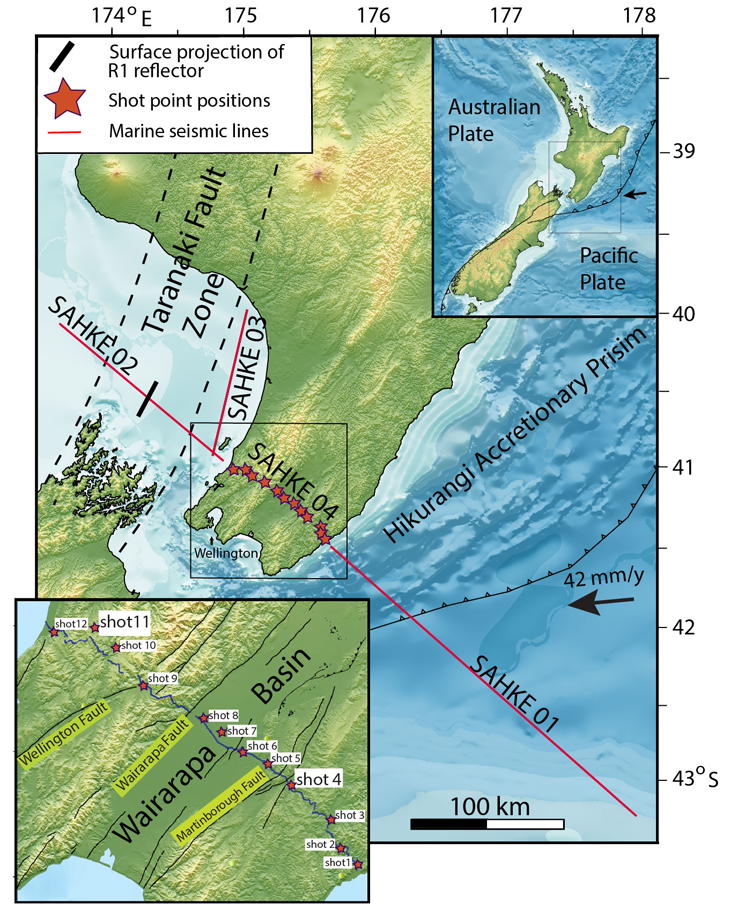
SLIP ‘N SLIDE A layer of slippery, partially melted rock (red) may separate the Pacific tectonic plate from the underlying mantle, reducing the amount of force required to shift the massive plate, new seismic research suggests.
Tim Stern
- More than 2 years ago
Using ricocheted vibrations from dynamite blasts, researchers have glimpsed a layer of gooey material sandwiched between the Pacific tectonic plate and the underlying mantle. If present beneath all plates, the layer of partially melted rock could help explain how tectonic plates slide around Earth’s surface so easily, the researchers report in the Feb. 5 Nature.
“A weak, slippery base essentially decouples the plate from the sticky, underlying mantle,” says lead author Tim Stern, a geophysicist at Victoria University of Wellington in New Zealand. “This gives us a good idea about the forces required to push and pull the plates around.”
Earth’s outermost shell is a fragmented jigsaw puzzle of rocky plates sliding over the mantle below. The bottoms of these plates can be hundreds of kilometers underground, making them much too thick to drill through. Geophysicists instead typically study the deep Earth by listening to earthquake waves moving through the ground. When a downward wave hits the boundary between two layers with different compositions, part of the wave reflects back toward the surface. By eavesdropping on these echoes using seismometers, geophysicists can reconstruct the structure of Earth’s interior.
Earthquake waves are too long to differentiate between underground features smaller than a few dozen kilometers thick, however. To precisely image the Pacific Plate where it dives beneath the Australian Plate near New Zealand, Stern and colleagues created their own vibrations using explosives. After placing 1,178 seismometers along an 85-kilometer stretch of New Zealand’s North Island, the researchers buried 12 half-metric-ton shots of dynamite 50 meters underground.
Over two nights in 2011, the team detonated one explosive charge each hour. The explosions were set off between midnight and 5 a.m. to minimize the number of trucks on nearby roads shaking the ground as they passed by the seismometers. Stern says that safely detonating the charges required “military-style precision and timing.”

When the researchers inspected the vibrations reflected back to the surface, they were amazed to see a clear boundary less than 1 kilometer thick at the bottom of the Pacific Plate, about 100 kilometers below ground. “We only expected to look down about 30 kilometers, so it was a big surprise that we could see down so far,” Stern says. “It was pure serendipity and luck that we got it.”
Also surprising, Stern says, was a 10-kilometer-thick layer crammed between the plate and the mantle. Stern estimates that this layer contains about 2 percent molten rock, probably melted by the shear created as the tectonic plate grinds over the mantle. This small amount of melt drastically reduces the strength of the rocky layer, Stern says, essentially lubricating the overlying plate’s movements.
The combination of an abrupt plate boundary and a weak bottom layer means less force is probably required to move the plate around, says geophysicist Simon Klemperer of Stanford University. The team’s findings suggest that the plate moves with less drag from the mantle than once thought, just like an ice-skater gliding on a thin layer of melted ice beneath her skates. This mechanism could help resolve the issue of plate tectonics requiring more force than available to shift the plates, a problem plaguing the theory since it first gained acceptance about 50 years ago, Klemperer says.
While Stern and colleagues imaged the slippery layer only beneath one part of one plate, previous studies may have caught fuzzy glimpses of it elsewhere in the world, says seismologist Vedran Lekic of the University of Maryland in College Park. “This discovery is so remarkable that we really need to reconsider other data that we’ve looked at before and analyze them for a layer like this,” he says.






